The history of Carroll Shelby is multifaceted, complex and fascinating. The movie Ford v Ferrari focuses on his involvement with the 24 Hours of Le Mans where he won the race outright with co-driver Roy Salvadori driving an Aston Martin in 1959. He then led the Ford team to wins with the Ford GT40 (sorry for the spoiler). He also created successful race cars: the Shelby Mustangs, starting in 1965 with the Shelby GT350, the Shelby Cobras (the subject of today’s article by our historian Wallace Wyss, the Shelby Cobra being the most replicated car sports car* in history), to be followed by the Peter Brock designed Shelby Cobra Daytona Coupe that won the FIA World GT Manufacture Championship in 1965. This is the only time this championship has been won by an American constructor. If Hollywood is interested there are a few more Carroll Shelby movies to be made.
Mike Gulett, Publisher
by Wallace Wyss –
Carroll Shelby is celebrated for the Cobra world wide, but truth be told, he didn’t design the chassis, the engine or the suspension or the body.
That was all done back in the Fifties when the car was known as the AC Ace designed in Thames Ditton England by AC Cars Ltd., a very old car company.
And actually, they didn’t design it either. The original idea came when a fellow, Jon Tojiero, a Brit with a Portugese father and English mother, who made one-off custom cars was given an assignment by a customer to design something that looked like a Ferrari. This was in the early ‘50s when the first Ferraris, like the 166 Barchetta, were first coming across the channel to England.
So the John Tojiero took two small Italian cars with transverse leaf suspensions and designed a tubular frame to hold the leaves at both ends and then added whatever off the shelf engine was available, one with a Bristol engine.
Those three cars had their impact. One person that saw one on display was Derek Hurlock, a director of AC Cars Ltd, and he bought the rights to one of the three customers of Tojiero and put that design into production as the AC Ace. Though Tojiero had designed the chassis, all he got out of it was a promise of a being paid a few pounds for each car sold.
The production Ace was a sports car fully capable of winning in the two liter class, and first used an AC two liter six that was an ancient design, but didn’t come alive until they switched to a Bristol six, another two liter that ironically was but a variation of the BMW 328 engine offered before the war.
When Shelby was still a race driver, he had at least once raced an AC Bristol and decided it was a good car, though underpowered compared to the Ferraris and Maseratis he was used to. But he didn’t forget the car and would come back to it a few years later.
After Shelby was forcibly retired from racing with a heart ailment, he kicked around for an occupation. One idea was a driving school. When people would send money for information as a result of a magazine ad, Shelby would take an auto editor out for lunch. When Shelby went to lunch with John Christy an editor at Sports Car Graphic, Christy told him that AC had lost Bristol as an engine supplier, that they were no longer going to supply sixes to AC.
Actually it wasn’t as much of an opportunity, because in short order AC had found a Ford 2.6 liter six that would do and began making the AC 2.6.
But that didn’t stop Shelby. He had wanted to make his own sports car for years and now was his chance. And he had several auto editors in California willing to promote whatever he came up with.
Now back when Shelby was racing, he had raced several British cars with American engines, including the Cadillac-Allard, and Nash Healey. So he had the theory that American racers wanted a car that was European designed and built but with American engines that were easy to fix and there were parts available.
The example right in front of him was playboy Lance Reventlow (heir to a vast fortune, his mother having married two rich husbands in succession) who had funded a sports car called the Scarab, built in the U.S. with Chevrolet engines. But Reventlow only built them for racing, passing up the chance to mass produce them.
Shelby ruminated on that and then remembered that a Ford engineer had told him at the Pike’s Peak hillclimb that Ford was bringing out a lightweight V8. Not an aluminum block or aluminum heads, mind you, but still, an engine a couple of hundred pounds lighter than the typical Detroit V8. It would displace 4.2 liters.
It would go in the Fairlane and the Falcon, both steel bodied compacts, but which weighed 1000 lbs. more than the AC, Shelby saw this as his golden opportunity.
Shelby was asked if he wanted a couple to experiment with and just so happens that with his last remaining nickel, he had ordered an AC Bristol from England and parked it at Dean Moon’s shop (Moon a hubcap maker and race car builder). Once the 4.2 liter V8 arrived from Michigan, Shelby took it out to Moon’s shop and it was squeezed into the AC Bristol.
Shelby had to strengthen other parts of the drivetrain because this was almost twice as much power as it had when it was powered by a Bristol six. When he was confident enough, he sent it his running prototype, still with the 4.2 V8, to AC Cars and then flew over the pond himself to test drive it on their company track. Things broke left and right but as each thing broke it was redesigned and pretty soon they had a sporty little sports car.
Shelby also met a rich racer in California who paved the way to mass production by ordering two more cars.
THE FAMOUS 289
By then Ford announced they were going upgrading that 4.2 to a 4.7 liter V8 (289 cu. in.) and several of those were sent to the shop and all plans for the 4.2 version were ditched. Shelby’s ace mechanic Phil Remington cobbled up a hand-made intake manifold that would hold four exotic transverse Italian made carburetors so the engine’s power could be unleashed.
But Shelby still decided to go with an aftermarket intake manifold and an American made four barrel carb. This was mated to a 4 speed transmission.
THE NAME GAME
Somewhere along the way Shelby decided to call the new car the Shelby Cobra. Now AC who was making the chassis, the body, interior and suspension, and sending the completed shells to Shelby, still badged it as the AC and were willing to call it the AC Cobra. But Shelby, as the cars arrived, peeled off their nose badge and put his own Shelby emblem on. He never quite expunged AC’s name from the car entirely though and later on AC sold a European version called the AC Cobra.
Shelby’s Phil Remington also redesigned the trunk lid making it less deep so the body would be more rigid and changed the wheel wells for the wider tires they would be running in America. The grille shape was also reshaped so the car looks like a brother to the AC ace but not a twin brother.
FORD SEES SHEL AS THEIR COWBOY HERO
Shelby took the first running one to Dearborn Michigan and presented it to a group of Ford executives including Lee Iacocca. Ford was on a High Performance binge, funding dozens of race cars in many motorsports just to get the name Ford a younger audience. They agreed to show the first Cobra, a yellow roadster, at the Ford booth at the New York Auto Show and the rest is history—orders poured in.
FORD BACKS SHELBY
Ford was willing to have their dealers sell AC Cobras out of Ford showrooms. But there was a production problem, the cars were made by hand in Thames Ditton, so only so many could be made a week. So over the next few years, Shelby managed to make around 1,000 of the small block ones, but they – “they” being the Shelby works team– did the job of practically driving the Corvettes from America’s race tracks, mostly due to being 1,000 lbs. lighter.
Ford sponsored a factory team of AC Cobras in American racing and even in Europe, where they raced at the 24 Heures du Mans. But though they could beat a Ferrari in their class, they couldn’t ever hope to win the race overall because they had an aerodynamic problem—the roadster body was like a brick aerodynamically, holding it down to 165 mph even with a fastback hardtop attached.
In ’64, Shelby’s last minute Hail Mary for the Cobra was the Daytona coupe, a car designed by a young man in his employ who had once been a student intern at GM Design. The designer, Pete Brock, wanted to make a fastback coupe version with a chopped off tail, a “Kamm effect” tail named for Dr. Wunibald Kamm, a German aerodynamicist who had worked on the theory of tapered tails vs. cut off tails, which made a car faster.
But though the Daytona coupe was successful in racing, helping Shelby American win the World Manufacturer’s Championship in 1965, it was undeveloped for street use and only six were made, all for racing.
THE BIG BLOCK
Shelby had reached the same conclusion that the Ford GT40 engineers had, that the only way to make the car faster was to go big block, the same 7 liter (427 cu. in.) FE block that Ford used in NASCAR. Of course it made the car heavier and the frame tubes were set further apart and upgraded to 4” diameter. Everything on the car was upgraded to deal with the brutal torque of the 7 liter. The biggest change mechanically was the switch to coil springs all around, that designed by a Ford engineer. The body also got a more voluptuous shape, sort of an Arnold Schwarzenegger treatment.
The 427 Cobra alas, was torpedoed by the FIA who wanted to make sure that at least 100 were built and sent an inspector to Shelby’s plant to count cars. Less than 60 had been made so it was refused entry into races as a production sports car, forced to run with faster lighter prototypes. Many orders were cancelled.
Shelby had been building a lot of race car versions and was saved from disaster when a fast thinking salesman said, “No problem, let’s just put the street equipment back on and call it the S/C,” presumably for “street competition.”
Shelby priced the big block Cobra at around $10,000, $3000 more than the small block. He figured out a way to make slightly more profit by slipping some out the door with 428 engines. Turns out the 428 engine cost Shelby $200 less and most buyers never knew. Out on a racetrack though the 428 did not have the longevity of the 427 side oiler. Today that would be “bait and switch” but back then such knavery was tolerated.
Under 400 big block Cobras were made. By late ’67 Shelby was already still enmeshed in Ford’s Le Mans racing program where they wanted to make certain everybody knew their ’66 victory was not a fluke. And the way to do that was to win again in ’67.
The Cobra faded away, the final numbers being 655 leaf-spring 289 Cobras and 343 coil-spring 427 Cobras. These numbers include street cars, competition cars, semi-competition roadsters, etc. Shelby closing his Cobra shop in the rented hanger at Los Angeles International Airport. But a few years later a British man Brian Angliss, who had been repairing AC Cobra began making one called the AC Cobra Mk. IV. Very entertaining to read decades later is the battle of letters that scorched the pages of England’s CAR magazine where Shelby and Angliss traded insults, Shelby insisting he and he alone had the rights to the AC Cobra. Angliss wasn’t selling it as the Cobra, but was able to sell several hundred to—surprise—U.S. Ford dealers who found customers even though the name Shelby wasn’t on the car.
Then came the replicas. First one company then dozens, these having fiberglass bodywork and a variety of engines, some small block, some big block. Shelby also inveighed against them but finally in a lawsuit that reached a district court was overruled in his claim that he alone owned the design; as his copyists could prove nothing about the Cobra shape was original; Shelby had merely adapted the AC Ace and AC had bought the design from an owner of a custom car in the beginning even Tojiero had admitted many times his one off customs were but copies of a Ferrari.
But after suing several replica companies Shelby finally decided if you can’t beat them join them and made a deal with various replica makers including Superformance, to make Cobras for him or to make their own but under license from Shelby. At the time of Shelby’ s death, several companies were still making them and Shelby American still selling them…
Let us know what you think of the Shelby Cobra history in the Comments.
THE AUTHOR: Shelby expert Wallace Wyss reports copies of SHELBY The Man, the Cars The Legend are still available from Enthusiast Books. Paintings are also available by commission, write Mendoart7@gmail.com
*Ron Lee mentioned to me on Jan. 13 that the ’32 Ford Roadster may be the most replicated car in history so I changed the wording to “sports car” describing the Shelby Cobra.
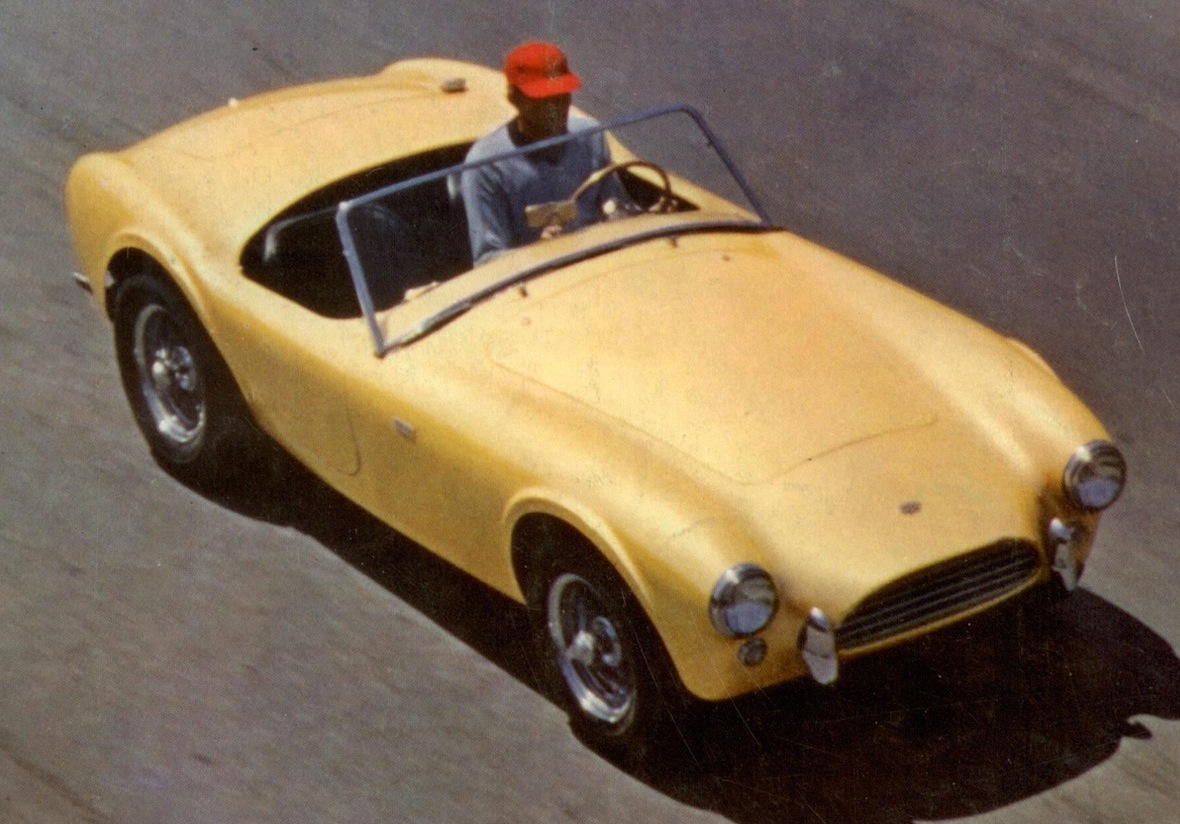
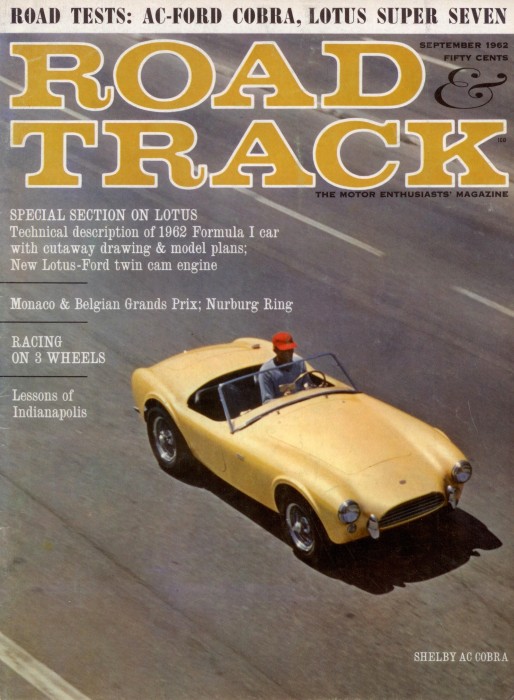
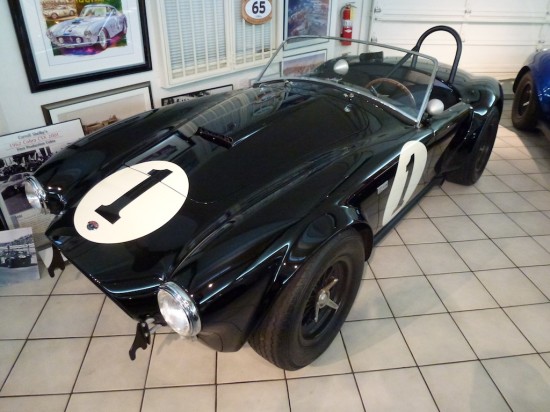
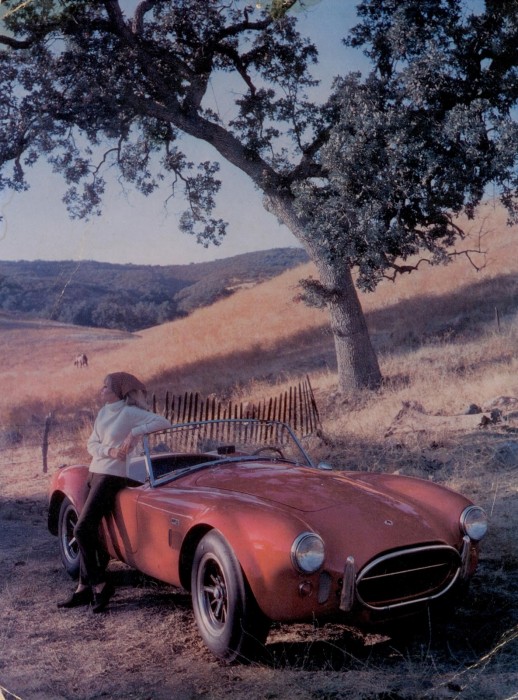

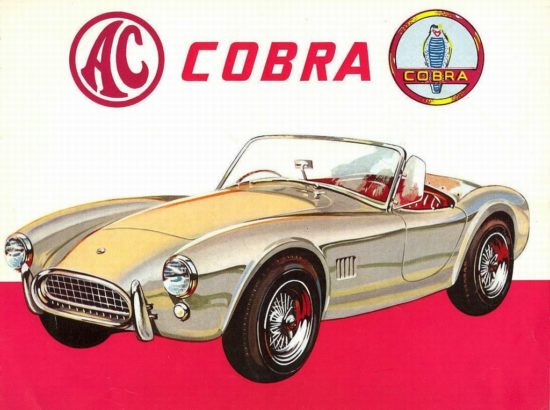
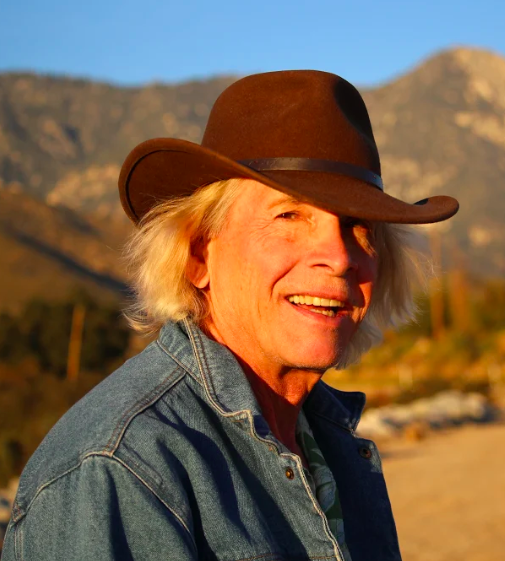
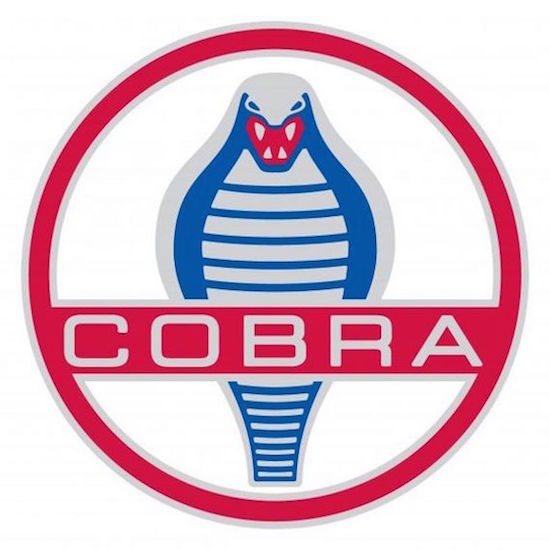
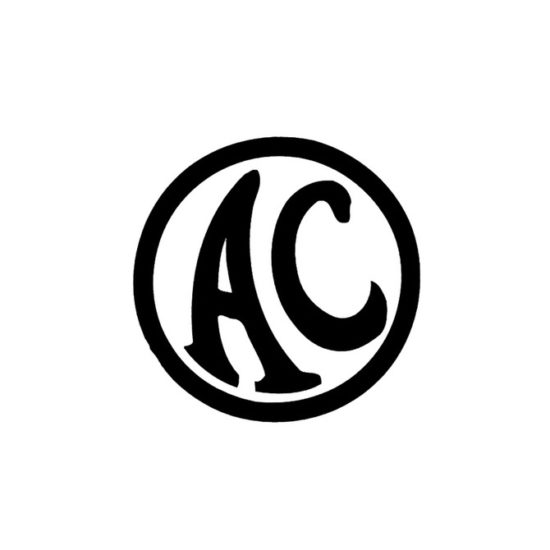


I still remember the time when a couple of friends and I drove to a Ford dealer that told us early that he had a couple of modified Mustangs.
We went over to have a look. but we also saw a couple of early Cobras. A real treat, and it pays to get to know someone with some pull.
All of the cars were in the upstairs storage area and tucked away from view.
I believe the Ford engineer at the Pikes Peek Hill climb was referring to the 221 cu in Windsor V8 not the 260 cu in that followed?
Great article and a fine read. Keep them coming.
Gregory